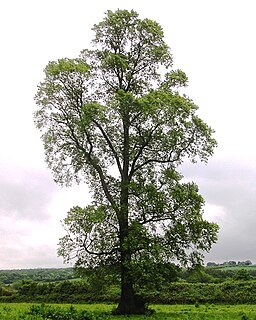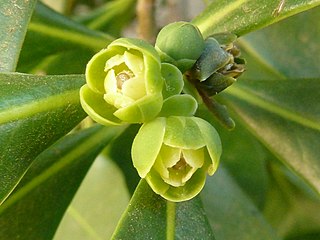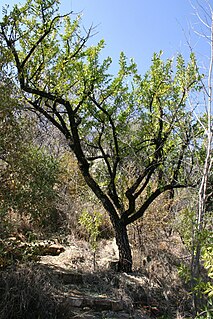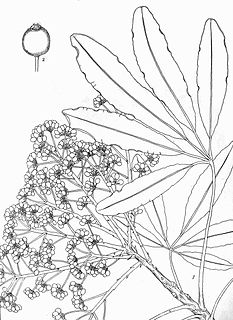
Elms are deciduous and semi-deciduous trees comprising the flowering plant genus Ulmus in the plant family Ulmaceae. The genus first appeared in the Miocene geological period about 20 million years ago, originating in what is now central Asia. These trees flourished and spread over most of the Northern Hemisphere, inhabiting the temperate and tropical-montane regions of North America and Eurasia, presently ranging southward in the Middle East to Lebanon, and Israel, and across the Equator in the Far East into Indonesia.

The field elm cultivar 'Atinia' , commonly known as the English elm, formerly common elm and horse may, and more lately the Atinian elm was, before the spread of Dutch elm disease, the most common field elm in central southern England, though not native there, and one of the largest and fastest-growing deciduous trees in Europe. R. H. Richens noted that elm populations exist in north-west Spain and northern Portugal, and on the Mediterranean coast of France that "closely resemble the English elm" and appear to be "trees of long standing" in those regions rather than recent introductions. Augustine Henry had earlier noted that the supposed English elms planted extensively in the Royal Park at Aranjuez from the late 16th century onwards, specimens said to have been introduced from England by Philip II and "differing in no respects from the English elm in England", behaved as native trees in Spain. He suggested that the tree "may be a true native of Spain, indigenous in the alluvial plains of the great rivers, now almost completely deforested".

The American Elm cultivar Ulmus americana 'Jefferson' was cloned from a tree growing near a path in front of the Freer Gallery of Art, close to the Smithsonian Institution Building on the National Mall in Washington, D.C. The United States National Park Service, which had planted the tree during the 1930s, cloned it in 1993 after screening tests showed that it possessed an outstanding level of tolerance to Dutch elm disease (DED).

The elm cultivar Ulmus 'Purpurea', the purple-leaved elm, was listed and described as Ulmus Stricta Purpurea, the 'Upright Purpled-leaved Elm', by John Frederick Wood, F.H.S., in The Midland Florist and Suburban Horticulturist (1851), as Ulmus purpureaHort. by Wesmael (1863), and as Ulmus campestris var. purpurea, syn. Ulmus purpureaHort. by Petzold and Kirchner in Arboretum Muscaviense (1864). Koch's description followed (1872), the various descriptions appearing to tally. Henry (1913) noted that the Ulmus campestris var. purpureaPetz. & Kirchn. grown at Kew as U. montana var. purpurea was "probably of hybrid origin", Ulmus montana being used at the time both for wych elm cultivars and for some of the U. × hollandica group. His description of Kew's U. montana var. purpurea matches that of the commonly-planted 'Purpurea' of the 20th century. His discussion of it (1913) under U. campestris, however, his name for English Elm, may be the reason why 'Purpurea' is sometimes erroneously called U. procera 'Purpurea' (as in USA and Sweden.

Vachellia nilotica is a flowering plant tree in the family Fabaceae. It is native to Africa, the Middle East and the Indian subcontinent. It is also a Weed of National Significance in Australia as well as a Federal Noxious Weed in the United States.

The elm cultivar Ulmus 'Berardii', Berard's Elm, was raised in 1865, as Ulmus Berardi, from seeds collected from large specimens of "common elm" growing on the ramparts at Metz, by an employee of the Simon-Louis nursery named Bérard. Carrière (1887), the Späth nursery of Berlin and the Van Houtte nursery of Gentbrugge regarded it as form of a Field Elm, listing it as U. campestris Berardii, the name used by Henry. Cheal's nursery of Crawley distributed it as Ulmus nitens [:Ulmus minor] 'Berardii'. Smith's of Worcester preferred the original, non-specific name, Ulmus 'Berardii'.

The dwarf wych elm cultivar Ulmus glabra 'Nana', a very slow growing shrub that with time forms a small tree, is of unknown origin. It was listed in the Simon-Louis 1869 catalogue as Ulmus montana nana. Henry (1913), referring his readers to an account of the Kew specimen in the journal Woods and Forests, 1884, suggested that it may have originated from a witch's broom. It is usually classified as a form of Ulmus glabra and is known widely as the 'Dwarf Wych Elm'. However, the ancestry of 'Nana' has been disputed in more recent years, Melville considering the specimen once grown at Kew to have been a cultivar of Ulmus × hollandica.

Pseudoclanis postica is a moth of the family Sphingidae first described by Francis Walker in 1856. It is known from South Africa and Zimbabwe.
Citropsis articulata, known commonly as the African cherry orange, West African cherry orange, Uganda cherry orange, and locally as omuboro, is a species of flowering plant in the citrus family, Rutaceae. It is native to tropical West Africa.

Warburgia salutaris is a species of tree in the family Canellaceae. It is found in eastern and southern African locations e.g. Botswana, Namibia, Tanzania, Zambia, Mozambique, South Africa, Eswatini, Malawi and Zimbabwe and Kenya. It is threatened by habitat loss. It is a popular medicinal plant and is overharvested in the wild, another reason for its endangerment. The Pepper-bark tree is a protected tree in South Africa. Various projects are investigating methods of propagation under controlled conditions with subsequent planting in the wild.

Protea aristata is a compact shrub with beautiful flowers which is endemic to the southwestern part of the Cape Region of South Africa. P. aristata has become one of South Africa's most famous proteas in spite of its relatively late discovery, and re-discovery in 1953. The leaves are soft, dense and needle-like and the flower heads are a stunning crimson red, it may thus be a good potential ornamental plant for South African gardens. It is usually called the Ladismith sugarbush in South African English, although it has been called pine sugar bush in Australia. In the Afrikaans language it has the vernacular name of klein-den-suikerbos.

Syzygium guineense is a leafy forest tree of the family Myrtaceae, found in many parts of Africa both wild and domesticated. Both its fruits and leaves are edible; the pulp and the fruit skin are sucked and the seed discarded. It is sometimes called "waterberry", but this may also refer to other species of Syzygium.

Gymnosporia heterophylla, the common spike-thorn, is a small, hardy, deciduous African tree up to 5m tall, occurring in rocky places with a wide distribution from Ethiopia, the Sudan and the Congo, south to the Cape Province and west to Angola and Namibia, as well as the neighbouring islands of Madagascar and Saint Helena, with a closely related species from Mauritius.

Cannabaceae is a small family of flowering plants. As now circumscribed, the family includes about 170 species grouped in about 11 genera, including Cannabis, Humulus (hops) and Celtis (hackberries). Celtis is by far the largest genus, containing about 100 species.

Adenia globosa is a species of flowering plant in the passionflower family, Passifloraceae. It is native to tropical Africa, where it occurs in Ethiopia, Kenya, Somalia, and Tanzania. It is known as mpaga in Swahili.

Combretum apiculatum is a species of tree in the family Combretaceae known by the common name red bushwillow. It is native to the mesic to semi-arid savanna regions of Africa, southwards of the equator.

Schefflera umbellifera is an evergreen to semi-deciduous Southern African tree of 15-20m growing in escarpment and coastal forest in Malawi, through eastern Zimbabwe and Mozambique along the east coast to South Africa, as far south as the Garden Route. It belongs to the Araliaceae or Cabbage Tree family and is one of some 600 species in the genus Schefflera, created by J.R.Forst. & G.Forst. in 1776 to honour the 18th century German physician and botanist Johann Peter Ernst von Scheffler of Danzig, and not to be confused with writer and physician Jacob Christoph Scheffler (1698-1745) of Altdorf bei Nürnberg.

Berberis holstii is a spiny evergreen shrub assigned to the barberry family, with simple leaves, hanging panicles with a few yellow flowers and eventually blackish-blue berries. It is one out of only species of Berberis that grow in the wild in Africa, where it can be found at high altitudes in Tanzania, Uganda, Kenya, Ethiopia, Somalia, and Malawi. It is also reported from Yemen and Oman. In Malawi it is known as Kayunga, while in Ethiopia it is called Gewo, Yeset af in Amharic, as well as Zinkila, a name also used in the Afar language, and Godxantool in the Somali language.

Hypericum ericoides is a dwarf shrub in the flowering plant family Hypericaceae, section Coridium. It is found in eastern and southeastern Spain, Morocco, and Tunisia. Its preferred habitat is fissures in calcareous rocks in warm, sunny places, from 200 to 2,000 meters above sea level (MASL).



















